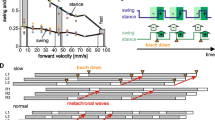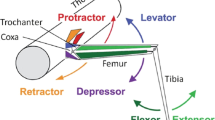Abstract
Stick insects were studied while walking on different substrates. The trajectories of swing movements are recorded. The starting position of a swing movement is varied in vertical direction and in the direction parallel to body long axis. The trajectories found cannot be predicted by an ANN (Swingnet1) proposed earlier to describe swing movements. However, a modified network (Swingnet2) allows for a satisfying description of the behavioral results. Walking on a narrow treadwheel leads to different swing trajectories compared to walking on a broad treadwheel. These trajectories cannot be described by Swingnet1, too. The form of the swing trajectory may depend on the direction of the force vector by which the leg acts on the ground in the preceding stance. Based on this assumption, an alternative hypothesis (Swingnet3) is proposed that can quantitatively describe all results of our experiment. When stick insects walk from a wide to a narrow substrate, transition between different swing trajectories does not change gradually over time. Rather, the form of the trajectory is determined by the current sensory input of the leg on a step-to-step basis. Finally, four different avoidance reflexes and their implementation into swing movements are investigated and described by a quantitative simulation.












Similar content being viewed by others
Abbreviations
- AEP:
-
Anterior extreme position
- CSP:
-
Coxal swing position
- CxTr:
-
Coxa–Trochanter joint
- FeTi:
-
Femur–Tibia joint
- PEP:
-
Posterior extreme position
- SEP:
-
Swing extreme position
- ThCx:
-
Thorax–Coxa joint
References
Akay T, Bässler U, Gerharz P, Büschges A (2001) The role of sensory signals from the insect coxa-trochanteral joint in controlling motor activity of the femur-tibia joint. J Neurophysiol 85:594–604
Bartling C, Schmitz J (2000) Reaction to disturbances of a walking leg during stance. J Exp Biol 203:1211–1233
Bässler U (1993) The walking- (and searching-) pattern generator of stick insects, a modular system of reflex chains and endogenous oscillators. Biol Cybern 69:305–317
Bässler U, Rohrbacher J, Karg G, Breutel G (1991) Interruption of searching movements of partly restrained front legs of stick insects, a model situation for the start of a stance phase? Biol Cybern 65:507–514
Bläsing B (2006) Crossing large gaps—a simulation of stick insect behaviour. Adaptive Behavior (in press)
Brown TG (1911) The intrinsic factors in the act of progression in the mammal. Proc R Soc Lond B 84:308–319
Brunn DE, Heuer A (1998) Cooperative mechanisms between leg joints of Carausius morosus, II Motor neuron activity and influence of conditional bursting interneuron. J Neurophysiol 79:2977–2985
Burrows M (1996) The neurobiology of an insect brain. Oxford University Press, Oxford
Büschges A, Schmitz J (1991) Nonspiking pathways antagonize the resistance reflex in the thoraco-coxal joint of stick insects. J Neurobiol 22:224-237
Cruse H (1976a) The control of the body position in the stick insect (Carausius morosus), when walking over uneven surfaces. Biol Cybern 24:25-33
Cruse H (1976b) On the function of the legs in the free walking stick insect Carausius morosus. J Comp Physiol 112:235-262
Cruse H (1979) The control of the anterior extreme position of the hindleg of a walking insect. Physiol Entomol 4:121-124
Cruse H (1985) Which parameters control the leg movement of a walking insect? II. The start of the swing phase. J Exp Biol 116:357-362
Cruse H (1990) What mechanisms coordinate leg movement in walking arthropods? Trends Neurosci 13:15-21
Cruse H (2002) The functional sense of “central oscillations” in walking. Biol Cybern 86:271–280
Cruse H, Bartling C (1995) Movement of joint angles in the legs of a walking insect, Carausius morosus. J Insect Physiol 41:761–771
Cruse H, Riemenschneider D, Stammer W (1989) Control of body position of a stick insect standing on uneven surfaces. Biol Cybern 61:71-77
Cruse H, Dautenhahn K, Schreiner H (1992) Coactivation of leg reflexes in the stick insect. Biol Cybern 67:369–375
Cruse H, Schmitz J, Braun U, Schweins A (1993) Control of body height in a stick insect walking on a treadwheel. J Exp Biol 181:141–155
Cruse H, Bartling C, Cymbalyuk G, Dean J, Dreifert M (1995) A modular artificial neural net for controlling a six-legged walking system. Biol Cybern 72:421–430
Cruse H, Kindermann T, Schumm M, Dean J, Schmitz J (1998) Walknet—a biologically inspired network to control six-legged walking. Neural Netw 11:1435– 1447
Dean J (1990) Coding proprioceptive information to control movement to a target: simulation with a simple neural network. Biol Cybern 63:115-120
Dean J, Wendler G (1982) Stick insects walking on a wheel: Perturbations induced by obstruction of leg protraction. J Comp Physiol 148:195-207
Dean J, Wendler G (1983) Stick insect locomotion on a walking wheel Interleg coordination of leg position. J Exp Biol 103:75-94
Delcomyn F (1971) Computer aided analysis of a locomotor leg reflex in the cockroach. Z vergl Physiol 74:427-445
Diederich B, Schumm M, Cruse H (2002) Stick insects walking along inclined surfaces. Integr Comp Biol 42:165–173
Dillmann R, Albiez J, Gassmann B, Kerscher T (2005) Biologically motivated control of walking machines. In: Armada M, González de Santos P (eds) Proceedings of the 7th international conference on climbing and walking robots, CLAWAR 2004. Springer, Berlin Heidelberg New York, pp 55–69
Dreifert M (1994) Plastizität im Laufverhalten der indischen Stabheuschrecke Carausius morosus: Experimentelle Untersuchungen und Modellierung mittels künstlicher neuronaler Netze. Diploma Thesis, University of Bielefeld
Dürr V (2001) Stereotypic leg searching movements in the stick insect:Kinematik analysis, behavioural context and simulation. J Exp Biol 204:1589–1604
Dürr V (2005) Context-dependent changes in strength and efficacy of leg coordination mechanisms. J Exp Biol 208:2253–2267
Dürr V, Ebeling W (2005) The behavioural transition from straight to curve walking: Kinetics of leg movement parameters and the initiation of turning. J Exp Biol 208:2237–2252
Dürr V, Matheson T (2003) Graded limb targeting in an insect is caused by the shift of a single movement pattern. J Neurophysiol 90:1754–1765
Dürr V, Schmitz J, Cruse H (2004) Behaviour-based modelling of hexapod locomotion: Linking biology and technical application. Arthropod Struct Develop 33:237–250
Ebeling W, Dürr V (2006) Perturbation of leg protraction causes context-dependent modulation of inter-leg coordination, but not of avoidance reflexes. J Exp Biol 209:2199–2214
Espenschied KS, Quinn RD, Beer RD, Chiel HJ (1996) Biologically-based distributed control and local reflexes improve rough terrain locomotion in a hexapod robot. Rob Auton Syst 18:59–64
Forssberg H (1979) Stumbling corrective reaction, a phase-dependent compensatory reaction during locomotion. J Neurophysiol 42:936–953
Frik M, Guddat M, Karatas M, Losch CD (1999) A novel approach to autonomous control of walking machines. In: Virk GS, Randall M, Howard D (eds) Proceedings of the 2nd international conference on climbing and walking robots CLAWAR 99, 13–15 September, Portsmouth. Professional Engineering Publishing Limited, Bury St. Edmunds, pp 333–342
Full RJ, Kubow TM, Schmitt J, Holmes P, Koditscheck DE (2002) Quantifying dynamic stability and maneuverbility in legged locomotion. Integr Comp Biol 42:149–157
Gabriel J, Büschges A (2006) Control of stepping velocity in a single insect leg during walking. Philos Trans R Soc (in press)
Giszter SF, Loeb E, Mussa-Ivaldi FA, Bizzi E (2000) Dense mapping of frog lumbar spinal cord: organization of force and muscle use. Hum Mov Sci 19:597–626
Graham D (1981) Walking kinetics of the stick insect using a low-inertia, counter-balanced, pair of independent treadwheels. Biol Cybern 40:49-58
Grillner S, Deliagina TG, Ekeberg Ö, El Manira A, Hill RH, Lansner A, Orlovsky GN, Wallén P (1995) Neural networks that co-ordinate locomotion and body orientation in lamprey. TINS 18:270–279
Hess D, Büschges A (1997) Sensorimotor pathways involved in interjoint reflex action of an insect leg. J Neurobiol 33:891–913
Hoffmann O (2005) Entwicklung und Anwendung eines Versuchsaufbaus zum Studium von Geradeaus- und Kurvenlauf der Stabheuschrecke Carausius morosus. Diploma Thesis, Universität Köln
Linder CR (2002) Self organisation in a simple task of motor control. In: Hallam B, Floreano D, Meyer J-A, Hallam J (eds) Proceedings of the 7th international conference on simulation of adaptive behavior. MIT Press, Cambridge, pp 185–194
Müller U, Clarac F (1990) Dactyl sensory influences on rock lobster locomotion. I Intrasegmental and intersegmental leg reflexes during standing and walking. J Exp Biol 148:89–112
Pearson KG, Franklin R (1984) Characteristics of leg movements and patterns of coordination in locusts walking on rough terrain. Intl J Robot Res 3:101-112
Pfeiffer F, Eltze J, Weidemann H-J (1995) Sex-legged technical walking considering biological principles. Rob Auton Syst 14:223–232
Pick S, Strauss R (2005) Goal-driven behavioral adaptations in gap-climbing Drosophila. Curr Biol 15:1473–1478
Pike AVL, Alexander A McN (2002) The relationship between limb-segment proportions and joint kinematics for the hind limbs of quadrupedal mammals. J Zool Lond 258:427–433
Ritzmann RE, Quinn RD, Fischer MS (2004) Convergent evolution and locomotion through complex terrain by insects, vertebrates and robots. Arthropod Struct Develop 33:361–379
Siegler MSV, Burrows M (1986) Receptive fields of motor neurons underlying local tactile reflexes in the locust. J Neurosci 6:507–513
Tryba AK, Ritzmann RE (2000) Multi-joint coordination during walking and foothold searching in the Blaberus Cockroach, I Kinematics and electromyograms. J Neurophysiol 83:3323–3336
Wendler G (1964) Laufen und Stehen der Stabheuschrecke, Sinnesborsten in den Beingelenken als Glieder von Regelkreisen. Z vergl Physiol 48:198-250
Zakotnik J (2006) Biomechanics and neural control of targeted limb movements in an insect. Doctoral Dissertation, Faculty of Biology, University of Bielefeld, Germany
Acknowledgements
This work was supported by DFG grant Cr58/10-1 and by the EC IST program SPARK. Experiments comply with the “Principles of animal care”, publication No. 86-23, revised 1985 of the National Institute of Health, and also with the current laws of the Federal Republic of Germany.
Author information
Authors and Affiliations
Corresponding author
Rights and permissions
About this article
Cite this article
Schumm, M., Cruse, H. Control of swing movement: influences of differently shaped substrate. J Comp Physiol A 192, 1147–1164 (2006). https://doi.org/10.1007/s00359-006-0147-0
Received:
Revised:
Accepted:
Published:
Issue Date:
DOI: https://doi.org/10.1007/s00359-006-0147-0




